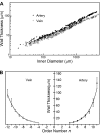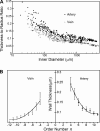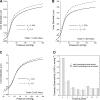Diameter-dependent axial prestretch of porcine coronary arteries and veins
- PMID: 22162531
- PMCID: PMC3311651
- DOI: 10.1152/japplphysiol.00857.2011
Diameter-dependent axial prestretch of porcine coronary arteries and veins
Abstract
The pressure-diameter relation (PDR) and the wall strain of coronary blood vessels have important implications for coronary blood flow and arthrosclerosis, respectively. Previous studies have shown that these mechanical quantities are significantly affected by the axial stretch of the vessels. The objective of this study was to measure the physiological axial stretch in the coronary vasculature; i.e., from left anterior descending (LAD) artery tree to coronary sinus vein and to determine its effect on the PDR and hence wall stiffness. Silicone elastomer was perfused through the LAD artery and coronary sinus trees to cast the vessels at the physiologic pressure. The results show that the physiological axial stretch exists for orders 4 to 11 (> 24 μm in diameter) arteries and orders -4 to -12 (>38 μm in diameter) veins but vanishes for the smaller vessels. Statistically, the axial stretch is higher for larger vessels and is higher for arteries than veins. The axial stretch λ(z) shows a linear variation with the order number (n) as: λ(z) = 0.062n + 0.75 (R(2) = 0.99) for artery and λ(z) = -0.029n + 0.89 (R(2) = 0.99) for vein. The mechanical analysis shows that the axial stretch significantly affects the PDR of the larger vessels. The circumferential stretch/strain was found to be significantly higher for the epicardial arteries (orders 9-11), which are free of myocardium constraint, than the intramyocardial arteries (orders 4-8). These findings have fundamental implications for coronary blood vessel mechanics.
Figures







Similar articles
-
Distribution of stress and strain along the porcine aorta and coronary arterial tree.Am J Physiol Heart Circ Physiol. 2004 Jun;286(6):H2361-8. doi: 10.1152/ajpheart.01079.2003. Am J Physiol Heart Circ Physiol. 2004. PMID: 15148060
-
Bifurcation asymmetry of the porcine coronary vasculature and its implications on coronary flow heterogeneity.Am J Physiol Heart Circ Physiol. 2004 Dec;287(6):H2493-500. doi: 10.1152/ajpheart.00371.2004. Am J Physiol Heart Circ Physiol. 2004. PMID: 15548725
-
Flow velocity is relatively uniform in the coronary sinusal venous tree: structure-function relation.J Appl Physiol (1985). 2017 Jan 1;122(1):60-67. doi: 10.1152/japplphysiol.00295.2016. Epub 2016 Oct 27. J Appl Physiol (1985). 2017. PMID: 27789767
-
Cardiac veins: a review of the literature.Clin Anat. 2009 Jan;22(1):129-45. doi: 10.1002/ca.20745. Clin Anat. 2009. PMID: 19097063 Review.
-
The venous drainage of the human myocardium.Adv Anat Embryol Cell Biol. 2003;168:I-VIII, 1-104. doi: 10.1007/978-3-642-55623-4. Adv Anat Embryol Cell Biol. 2003. PMID: 12645157 Review.
Cited by
-
Biomechanical effects of hemin and sildenafil treatments on the aortic wall of chronic-hypoxic lambs.Front Bioeng Biotechnol. 2024 Jul 3;12:1406214. doi: 10.3389/fbioe.2024.1406214. eCollection 2024. Front Bioeng Biotechnol. 2024. PMID: 39021365 Free PMC article.
-
A General Approach to Derive Stress and Elasticity Tensors for Hyperelastic Isotropic and Anisotropic Biomaterials.Int J Comput Methods. 2018 Jun;15(1):1850028. doi: 10.1142/S0219876218500287. Epub 2017 Sep 28. Int J Comput Methods. 2018. PMID: 30774174 Free PMC article.
-
Branching Pattern of the Cerebral Arterial Tree.Anat Rec (Hoboken). 2019 Aug;302(8):1434-1446. doi: 10.1002/ar.23994. Epub 2018 Dec 5. Anat Rec (Hoboken). 2019. PMID: 30332725 Free PMC article.
-
Pulsatile arterial wall-blood flow interaction with wall pre-stress computed using an inverse algorithm.Biomed Eng Online. 2015;14 Suppl 1(Suppl 1):S18. doi: 10.1186/1475-925X-14-S1-S18. Epub 2015 Jan 9. Biomed Eng Online. 2015. PMID: 25603022 Free PMC article.
-
Mechanobiological model of arterial growth and remodeling.Biomech Model Mechanobiol. 2018 Feb;17(1):87-101. doi: 10.1007/s10237-017-0946-y. Epub 2017 Aug 19. Biomech Model Mechanobiol. 2018. PMID: 28823079 Free PMC article.
References
-
- Alfonso F, Macaya C, Goicolea J, Hernandez R, Segovia J, Zamorano J, Bañuelos C, Zarco P. Determinants of coronary compliance in patients with coronary artery disease: an intravascular ultrasound study. J Am Coll Cardiol 23: 879–84, 1994 - PubMed
-
- Berry CL, Sosa-Melgarejo JA, Greenwald SE. The relationship between wall tension, lamellar thickness, and intercellular junction in the fetal and adult aorta: its relevance to the pathology of dissecting aneurysm. J Pathol 169: 15–20, 1993 - PubMed
-
- Choy JS, Dang Q, Molloi S, Kassab GS. Nonuniformity of axial and circumferential remodeling of large coronary veins in response to ligation. Am J Physiol Heart Circ Physiol 290: H1558–H1565, 2006 - PubMed
-
- Chuong CJ, Fung YC. On residual stresses in arteries. J Biomech Eng 108: 189–192, 1986 - PubMed
Publication types
MeSH terms
Substances
Grants and funding
LinkOut - more resources
Full Text Sources
Other Literature Sources
Miscellaneous

